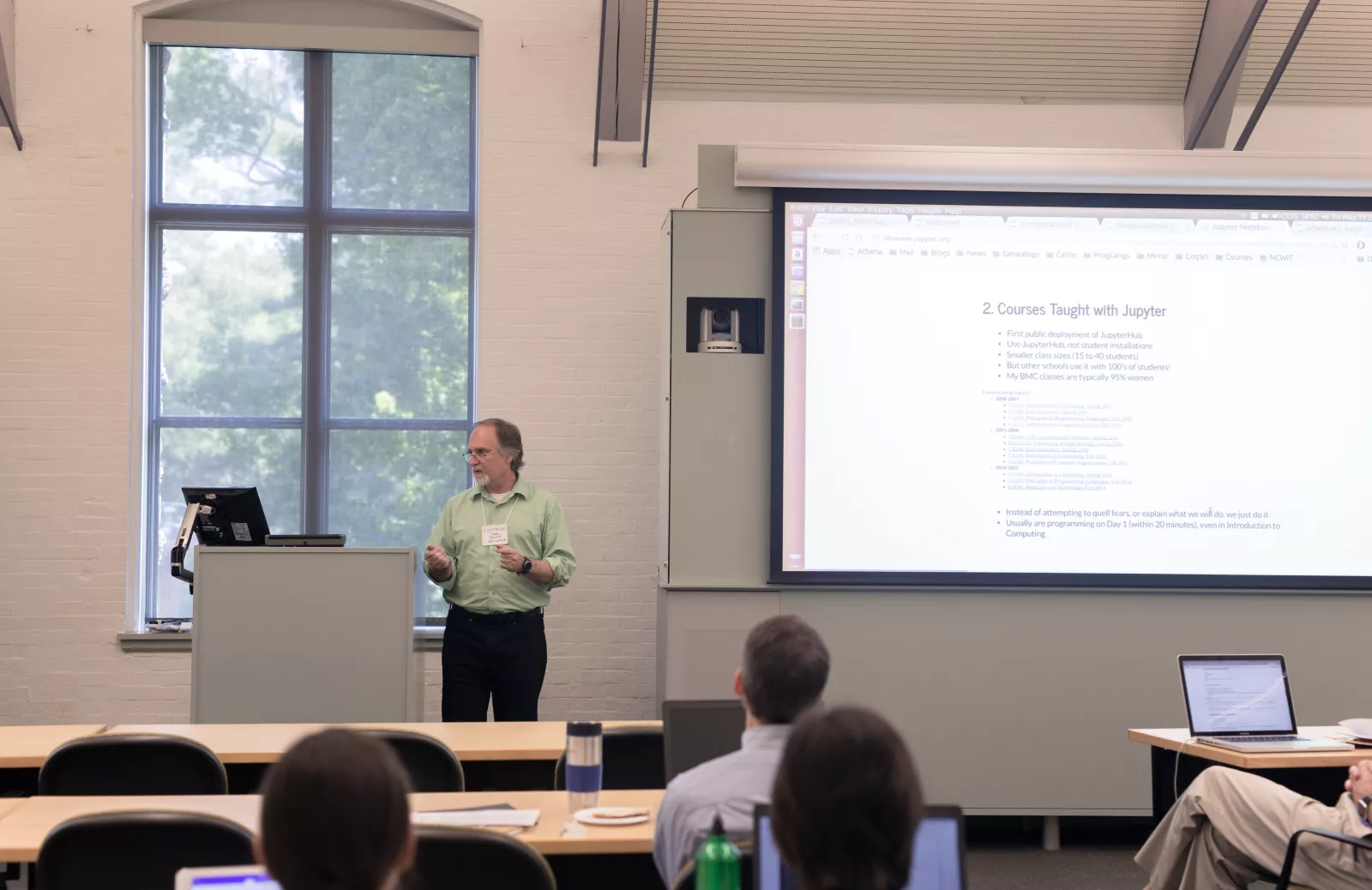
JupyterDayPhilly took place May 19, 2017 at Bryn Mawr College. (See our previous post on Jupyter Notebooks—they're interactive online books that let users mix live computation with narrative.) Users explored the advantages and challenges of using the Notebooks across a range of disciplines. It was a powerful demonstration that STEM fields increasingly value digital proficiency, making tools like the Notebooks, and the digital competencies they encourage, useful in a wide range of fields.
Biology
Joshua Shapiro [SLIDES] from Bryn Mawr explained that biology is moving in the direction of computing. He was eager to figure out a way to introduce computational methods to undergraduates as early as possible and make the case to students about the usefulness of computational skills to work and post-graduate education. "If you want to do something interdisciplinary," notes Shapiro, "you have to plan from day 1." To address this issue, he discussed designing a new course on "Computing Through Biology," an alternative to the second semester of introductory biology and also to introductory computer science. The course counts in both departments.
Physics
Aaron Titus from High Point University discussed using Jupyter Notebooks for physics. Titus suggested that the notebooks helped him engage students in undergraduate research in their first year. He explained that the immediately responsive visualizations built into Jupyter helped students model and test complicated information like magnetic fields. Titus notes that these methods help create richer assessment. "The original exam question would have been something like 'Find the equation of motion,'" states Titus. The new exam question? "Find the equation of motion... and then model it, and see what it does." Mark Matlin [SLIDES] from Bryn Mawr’s physics department also discussed his experience with Jupyter Notebooks and how he's refined his teaching with them over time, for instance by building in regular breakpoints within learning modules for students to test their understanding.
Math
For Jacob Koehler [SLIDES], working in math at New York University, the main concern is about access. Since he works with a diverse student population from all backgrounds, he was concerned about using proprietary software or programs that only run well on expensive computers. Koehler used Jupyter notebooks to walk students through the process of defining and plotting mathematical functions. A bonus of the notebooks is that students can ask questions in the chat box, without intimidation. "We want students to be talking about their work and communicating their thought processes," notes Koehler, but that is "nearly impossible to do in a classroom pencil and paper dominant technologies."
Computer Science
Most speakers emphasized the usefulness of having narrative and computational forms closely intermingled, as they are in Jupyter Notebooks. Doug Blank [SLIDES] from Bryn Mawr's computer science program stated that the notebooks are especially useful for novice learners trying to get past the first hurdles of coding: "Instead of attempting to quell fears, or explain what we do, we just do it" says Blank.
Further Thoughts
The main obstacle that emerged repeatedly is setting up and maintaining the notebooks, particularly for group collaboration; it requires technical ability and is not always easy for people to pick up. Gunjan Baid, [SLIDES] a recent graduate of UC Berkeley, discussed the use of Jupyter Notebooks in a "Foundations of Data Science" course taken by 50 majors and over a thousand users in the fall semester. The notebooks, says Baid, effectively “lower computational barriers to entry for introductory students,” though a project of this size requires constant supervision of the system by a group of TAs. Keynote speaker Andrew Odewahn [PAPER] of O’Reilly Media, which publishes many books in Jupyter format, noted the difficulties even of sending Jupyter books to reviewers. Maneesha Shane [SLIDES] from Data Carpentry suggests that "installation is the biggest headache" for notebooks, and explored the advantages and disadvantages to teaching coding in a Notebook vs. teaching it on the command line: she ultimately concluded that it’s helpful to learn in both formats. Ultimately, the participants felt that despite some hurdles, the notebooks were transformative teaching tools. As Luis Marti from Universidade Federal Fluminense [SLIDES] explored in his keynote, science pushes for reproducible, replicable results. Jupyter Notebooks are built around an ethos of open source, open data, which Marti argues does not just help teach the topic, but also encourages curiosity and good citizenship. I was left convinced about the usefulness of computational methods across a wide range of STEM disciplines, and about the efficacy of the Notebooks in helping users explore such methods.